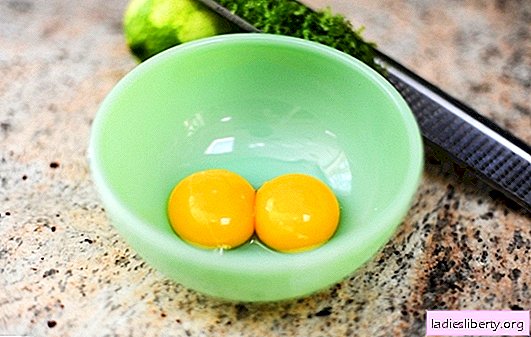
The egg, as well as its main components, namely the yolk and protein, is a very popular ingredient in many recipes, ranging from omelettes to baking. But few know exactly what the benefits of the yolk are, and how this product is harmful.
Description and composition of the yolk
The yolk is a source of nutrients that accumulate in the body of a living creature. They are in the form of plates or grains, and in some cases this component is mixed into one consistency. Scientists call the yolk deuteroplasm and for their chemical composition they are divided into 3 types:
● protein;
● fatty;
● carbohydrate.
The yolk in the eggs of various animals is located in different numbers and in varying degrees of uniformity. By this variety, isolecital and telolecital eggs are distinguished.
Energy value of the yolk:
● 16.4 grams of protein;
● 30.87 grams of fat;
● 1.78 grams of carbohydrates;
● 360 kcal calories per 100 grams of product.
The benefits of yolk - details about vitamins, elements and acids
The beneficial substances in the egg are in huge numbers, especially in the deuteroplasm. The benefits of the yolk are mainly based on the vitamins and minerals that abound in it. The composition of this product includes:
● vitamins;
● trace elements;
● unsaturated fatty acids, including omega-3 and omega-6;
● melatonin;
● β-carotene and others.
The vitamins that it contains:
● vitamin A;
● vitamin B6;
● vitamin B9;
● vitamin B2;
● vitamin B3;
● vitamin B1;
● vitamin B5;
● vitamin B7
● vitamin E;
● vitamin D;
● Vitamin H.
Also in the yolk there are such fatty acids:
● linoleic acid;
● palmitic acid;
● palmitoleic acid;
● linolenic acid;
● stearic acid;
● oleic acid;
● myristic acid.
Of the useful trace elements in the yolk contains:
● calcium;
● potassium;
● zinc;
● iron;
● phosphorus;
● selenium;
● magnesium.
The presence of these trace elements provides a beneficial effect on various organs and tissue compounds.
Elements that are contained in the yolks are of great benefit to the human body. For example, choline ensures the normalization of the metabolism of fat and protein, as well as the normal functioning of the central nervous system. Melatonin is responsible for the emergence and renewal of new cells, contributing to the rejuvenation process.
Vitamins that belong to group B normalize various processes associated with exchanges. Vitamin B12 is a prophylaxis against anemia and supports the overall tone of the body. Retinol is responsible for the regeneration of tissue compounds, and also strengthens the immune system. Calciferol (or Vitamin D) provides health for the musculoskeletal system and also removes heavy toxins from the body.
Significant benefits of the yolk are noted in the culinary business. Eggs are the main ingredient in mayonnaise and Dutch sauce. Due to its unique properties, often the yolk acts as a thickener in many recipes. In addition, it contributes to the enrichment of the structure of the dish, various custards, as well as dough for baking.
What harm from the yolk
The yolk harm is mainly based on the presence of cholesterol and fats. The latter stimulate, at the same time, the production of testosterone. And cholesterol not only harms the body, but also benefits. Yolk cholesterol practically does not accumulate in the body of a healthy person, but is completely dissolved, due to which hormones and vitamins are produced.
Problems arise with haughty eating eggs. It is then that the level of cholesterol increases, which forms plaques on the blood vessels.
But in fact, an increase in cholesterol is individual for each person. A lot of studies have shown that each body reacts differently to regular egg consumption: some did not have any changes in the body, others had significantly increased cholesterol levels, and some even felt better.
Another danger that the yolks hide in themselves is salmonella. These are rod-shaped bacteria that cause salmonellosis. It is an infectious disease that seriously affects the organs of the gastrointestinal tract, and is very difficult for the entire time.
This disease is very difficult to treat, since Salmonella bacteria are very resistant to their negative effects, adverse conditions, and also to some antibiotics. They are colonized in the intestine, attaching to its shell and making an introduction into tissue compounds. At the same time, they secrete dangerous toxins that poison the human body, causing a painful condition, diarrhea and vomiting.
Salmonella bacteria have the ability to affect not only the gastrointestinal tract, but also go beyond it. They can travel through the blood stream to other organs and tissues of a person. Salmonella can also be affected by the liver, heart, and certain lining of the brain. In view of this, damage to this type of bacteria can cause a complication at any time.
This can be avoided through proper product handling and the right choice in the store. You need to buy fresh eggs that do not have any flaws in the shell. When used, it is desirable to heat them.
This product is not recommended for people who have serious diseases with the cardiovascular system, as well as those who are obese. In this case, eating eggs can actually be harmful.
Which yolk is better
Egg lovers may wonder what is the best way to consume the yolk so that it benefits. Use cases may be as follows:
1. In its raw form. Eating an egg in its raw form is much easier, simpler and faster, since the egg does not need to be processed. But this version of the egg is not fully absorbed, but only 50%. In addition, there is a huge risk of contracting salmonellosis due to bacteria that may be in the yolk. And the lack of heat treatment greatly contributes to this. But lovers of this raw type of food can eat quail eggs, since there are no such bacteria there.
2. Fried. The easiest and fastest way to process this product and cook food is to make scrambled eggs. Although with prolonged roasting of the yolk, the possibility of contracting a dangerous bacterium sharply decreases, but at the same time, it contributes to the destruction of all useful trace elements and vitamins. In addition, this method contributes to the release of trans fats, which are very harmful to the body, especially to the liver. But the body absorbs fried eggs much better than raw ones.
3. Boiled. This is the most useful way to process such a product. The body almost completely assimilates the boiled egg, absorbing all the nutrients and trace elements that are stored during cooking. Also, this type of egg has no traces of fat, so the yolk in this form is practically not dangerous.
How much can you eat eggs, in particular yolks? There is no universal answer that suits every person. Each organism is individual and for each there is a limit. It is recommended to consume no more than 1-2 eggs per day.











